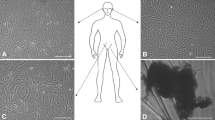Summary
In vitro, human dermal fibroblasts (HDF) differentiate through morphologically and biochemically identified compartments. In the course of this spontaneous differentiation through mitotic and postmitotic states, a tremendous increase in cellular and nuclear size occurs. Induction of postmitotic states can be accelerated by chemical (e.g., mitomycin C) or physical (e.g., x-ray) treatments. Such experimentally induced postmitotic HDF cells support very efficiently the growth of cutaneous epithelial cells, i.e. interfollicular keratinocytes and follicular outer root sheath cells, especially in primary cultures starting from very low cell seeding densities. The HDF feeder system provides more fundamental and also practical advantages, i.e. use of initially diploid human fibroblasts from known anatomic locations, easy handling and excellent reproducibility, and the possibility of long-term storage by incubation at 37°C. Conditions for the cryogenic storage of postmitotic HDF cells in liquid nitrogen are presented and related to the feeder capacity for epithelial cell growth. Because postmitotic HDF cells preserve intact feeder properties after long-term storage, the immediate availability of feeder cells and the possibility to repeat experiments with identical materials further substantiate the usefulness of this feeder system.
Similar content being viewed by others
References
Bayreuther, K.; Rodemann,H. P.; Hommel, R., et al. Human skin fibroblasts in vitro differentiate along a terminal cell lineage. Proc. Natl. Acad. Sci. USA 85:5112–5116; 1988.
Bayreuther, K.; Rodemann, H. P.; Francz, P. I., et al. Differentiation of fibroblasts stem cells. J. Cell Sci. Suppl. 10:115–130; 1988.
Francz, P. I.; Bayreuther, K.; Rodemann, H. P. Cytoplasm-, nuclear-, membrane bound-, and secreted (35S)-methionine polypeptide pattern in differentiating fibroblast stem cell in vitro. J. Cell. Sci. 92:231–239; 1989.
Limat, A.; Hunziker, T.; Boillat, C., et al. Post-mitotic human dermal fibroblasts efficiently support the growth of human follicular keratinocytes. J. Invest. Dermatol. 92:758–762; 1989.
Limat, A.; Noser, F. K. Serial cultivation of single keratinocytes from the outer root sheath of human scalp hair follicles. J. Invest. Dermatol. 87:485–488; 1986.
Rheinwald, J. G. Serial cultivation of normal human epidermal keratinocytes. In: Harris, C. C.; Trump, B. F.; Stoner, G. D., eds. Methods in cell biology, vol. 21A. New York: Academic Press; 1988:229–254.
Rheinwald, J. G.; Green, H. Formation of a keratinizing epithelium in culture by a cloned cell line derived from a teratoma. Cell 6:317–330; 1975.
Rheinald, J. G.; Green, H. Serial cultivation of strains of human epidermal keratinocytes: the formation of keratinizing colonies from siongle cells. Cell 6:331–344; 1975.
Rodemann, H. P.; Bayreuther, K.; Francz, P. I., et al. Slective enrichment and biochemical characterization of seven human skin fibroblasts cell types in vitro. Exp. cell Res. 180:84–93; 1989.
Sly, W. S.; Grubb, J. Isolation of fibroblasts from patients. In: Jakoby, W. B.; Pastan, I. H., eds. Cell culture. Methods in enzymology, vol. 58., New York: Academic Press; 1979:440–450.
Wu, Y. J.; Parker, L. M.; Binder, N. E., et al. The mesothelial keratins: a new family of cytoskeletal proteins identified in cultured mesothelial cells and nonkeratinizing epithelial. Cell 31:693–703; 1982.
Author information
Authors and Affiliations
Rights and permissions
About this article
Cite this article
Limat, A., Hunziker, T., Boillat, C. et al. Postmitotic human dermal fibroblasts preserve intact feeder properties for epithelial cell growth after long-term cryopreservation. In Vitro Cell Dev Biol 26, 709–712 (1990). https://doi.org/10.1007/BF02624427
Received:
Accepted:
Issue Date:
DOI: https://doi.org/10.1007/BF02624427




